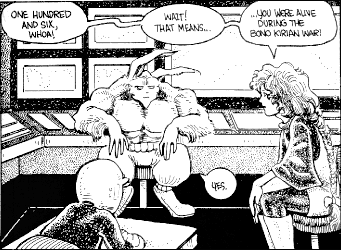
 Wandering Star
(Pen & Ink, Sirius)
Wandering Star
(Pen & Ink, Sirius)by Teri Sue Wood
21-issue limited series
Rating:
![]() Years overdue and 75% over-size, Wandering Star has finally concluded. The series began in 1993 and was to last 12 issues, taking perhaps a couple years to tell. More than four years and 21 issues later, it's finished. But it was worth the wait.
Years overdue and 75% over-size, Wandering Star has finally concluded. The series began in 1993 and was to last 12 issues, taking perhaps a couple years to tell. More than four years and 21 issues later, it's finished. But it was worth the wait.

![]() Understand that I'm the kind of person who "collects" limited series without reading them, to read in one sitting when they're finished. I'll pick up an issue or two and stop reading; if I like what I see, I'll keep buying it. In this case, I picked up the "volume one" trade paperback of the series - collecting the first "half" (seven issues) - read it, and then patiently bought every issue to come out since, as Teri Wood's estimate of how long it would be... grew. So while some readers were (im)patiently waiting during some of the long gaps between issues (caused by the usual assortment of personal and professional SNAFUs), I was just waiting for one issue: the last.
Understand that I'm the kind of person who "collects" limited series without reading them, to read in one sitting when they're finished. I'll pick up an issue or two and stop reading; if I like what I see, I'll keep buying it. In this case, I picked up the "volume one" trade paperback of the series - collecting the first "half" (seven issues) - read it, and then patiently bought every issue to come out since, as Teri Wood's estimate of how long it would be... grew. So while some readers were (im)patiently waiting during some of the long gaps between issues (caused by the usual assortment of personal and professional SNAFUs), I was just waiting for one issue: the last.
![]() Wandering Star is set in the distant future, decades after the people of Earth helped the peace-loving Galactic Alliance fight off the invading Bono Kiro. You see, the members of the alliance had given up war early in their cultural evolution, and needed the "barbaric" Earthers to mount a military defence. The fact that we saved the Alliance was reason enough for the other races to tolerate - but not respect - us. We were despised as savages who'd nearly destroyed our own world, both ecologically and through the development of a weapon that could destroy it completely. Casandra Andrews, daughter of Earth's president, was the first human allowed to attend the Galactic Academy. Wandering Star is her story.
Wandering Star is set in the distant future, decades after the people of Earth helped the peace-loving Galactic Alliance fight off the invading Bono Kiro. You see, the members of the alliance had given up war early in their cultural evolution, and needed the "barbaric" Earthers to mount a military defence. The fact that we saved the Alliance was reason enough for the other races to tolerate - but not respect - us. We were despised as savages who'd nearly destroyed our own world, both ecologically and through the development of a weapon that could destroy it completely. Casandra Andrews, daughter of Earth's president, was the first human allowed to attend the Galactic Academy. Wandering Star is her story.

![]() She tells her story in flashback, as a middle-aged woman recounting it to an alien writer. It's a stock literary device, one that simultaneously allows us to get inside the protagonist's head, while still allowing the narrator to fill in information the hero wouldn't know (at the time). Right off the bat, Wood gives us a handful of "spoilers", indicating that A) there was another war, and B) what happens to several key characters afterward. So there's never any suspense about whether the Bono Kiro will return or if Mekon dies. The story is about the journey, not so much the destination. And what's left unsaid (e.g. how did the war end?) provides enough suspense to keep the pages turning.
She tells her story in flashback, as a middle-aged woman recounting it to an alien writer. It's a stock literary device, one that simultaneously allows us to get inside the protagonist's head, while still allowing the narrator to fill in information the hero wouldn't know (at the time). Right off the bat, Wood gives us a handful of "spoilers", indicating that A) there was another war, and B) what happens to several key characters afterward. So there's never any suspense about whether the Bono Kiro will return or if Mekon dies. The story is about the journey, not so much the destination. And what's left unsaid (e.g. how did the war end?) provides enough suspense to keep the pages turning.
![]() Wood's art starts strong, and gets gradually stronger as the series progresses. It seems a bit more "careful" in the earlier issues, with more fine line work, but I think the confidence and strength of it improves. Wood uses hardly any simple hatching or crosshatching in the early issues, and very little even near the end; instead she fills grey or shaded areas with tiny little dots (of varying spacing and size), or tiny spiral patterns (that I would expect to drive one crazy to draw). It appears that some of this painstaking attention to detail had to be sacrificed to keep up with the almost-monthly schedule of the last year. It's still good very work, however.
Wood's art starts strong, and gets gradually stronger as the series progresses. It seems a bit more "careful" in the earlier issues, with more fine line work, but I think the confidence and strength of it improves. Wood uses hardly any simple hatching or crosshatching in the early issues, and very little even near the end; instead she fills grey or shaded areas with tiny little dots (of varying spacing and size), or tiny spiral patterns (that I would expect to drive one crazy to draw). It appears that some of this painstaking attention to detail had to be sacrificed to keep up with the almost-monthly schedule of the last year. It's still good very work, however.

![]() One of the series' few real shortcomings is the portrayal of the technological side of the future. I don't mind that Wood takes artificial gravity, food synthesizers, faster-than-light travel, and interspecies communication for granted... those are staples of the genre, and easily accepted via suspension of disbelief. But for a series named after a spaceship, the ships themselves (and most of the exterior "space" scenes) are rendered with almost childlike simplicity. These boxes with laser beams and rocket trails attached to them stand in noticeable contrast to the carefully-modeled figures that populate and pilot them. I wouldn't want the tech to overshadow or distract from the character interaction (which is the real focus of the story), but I found its simplistic depiction a little distracting.
One of the series' few real shortcomings is the portrayal of the technological side of the future. I don't mind that Wood takes artificial gravity, food synthesizers, faster-than-light travel, and interspecies communication for granted... those are staples of the genre, and easily accepted via suspension of disbelief. But for a series named after a spaceship, the ships themselves (and most of the exterior "space" scenes) are rendered with almost childlike simplicity. These boxes with laser beams and rocket trails attached to them stand in noticeable contrast to the carefully-modeled figures that populate and pilot them. I wouldn't want the tech to overshadow or distract from the character interaction (which is the real focus of the story), but I found its simplistic depiction a little distracting.
![]() I have no such complaints about the lettering. There's a strong trend toward computer lettering lately, and Wood's hand lettering is a perfect example of why that bothers me. By making the letters just a little bit larger or darker, she provides clear cues to a character's tone or pattern of voice, and when a they really emote, there's no question about it. That kind of instinctive subtlety simply cannot be conveyed with a computer-reproduced font.
I have no such complaints about the lettering. There's a strong trend toward computer lettering lately, and Wood's hand lettering is a perfect example of why that bothers me. By making the letters just a little bit larger or darker, she provides clear cues to a character's tone or pattern of voice, and when a they really emote, there's no question about it. That kind of instinctive subtlety simply cannot be conveyed with a computer-reproduced font.
![]() And what Wood conveys with all of this is a very compelling, emotionally powerful story. Having recently experienced some losses in my life, I could relate well to the (somewhat different) losses experienced by Casi during this second Bono Kirian War. As this young woman sees her universe - one she thought she understood and knew her place in - fall apart around her, to be replaced by something altogether different - something frightening and bitter - I can understand her reactions, and empathise with how she deals with them. In the process, I've come to understand myself a little bit better as well. You can't ask much more from a book.
And what Wood conveys with all of this is a very compelling, emotionally powerful story. Having recently experienced some losses in my life, I could relate well to the (somewhat different) losses experienced by Casi during this second Bono Kirian War. As this young woman sees her universe - one she thought she understood and knew her place in - fall apart around her, to be replaced by something altogether different - something frightening and bitter - I can understand her reactions, and empathise with how she deals with them. In the process, I've come to understand myself a little bit better as well. You can't ask much more from a book.
![]()

![]() This book can be discussed in rec.arts.comics.misc
This book can be discussed in rec.arts.comics.misc
![]() More reviews of all kinds of comics
More reviews of all kinds of comics
![]() More reviews of Sci-Fi comics
More reviews of Sci-Fi comics
![]() The main Beek's Books menu
The main Beek's Books menu
![]() Comments?
Comments?
© Todd VerBeek, Radio ZeroTM